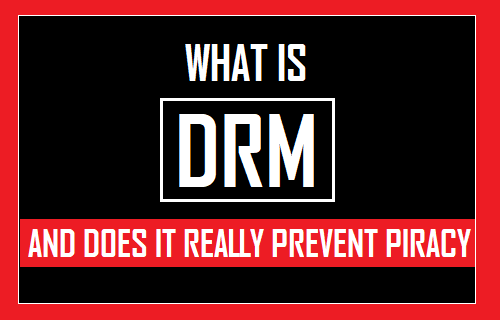If you read books and listen to music, it is likely that you have come across DRM protected content. So, let us go ahead and take a look at What is Digital Rights Management (DRM) and does it really prevent Piracy?.

What Is Digital Right Managment (DRM)?
DRM (Digital Rights Management) can be broadly defined as any technology designed to protect copyrighted content by preventing people from copying, modifying, sharing or distributing digital content.
In general, most DRM protection systems work by encrypting content and setting up a system to access copyrighted content using encryption keys.
The encryption key is tied to ID Number of the user’s machine. The key works only when the DRM protected file (eBook, Music file, etc.) is accessed from the same computer on which the file was originally installed.
In case of software programs like Microsoft Office or Norton Antivirus, the protection key resides on cloud servers managed by the vendors.
When anyone installs a protected software program, the user’s computer contacts the vendor’s server for a verification key and permission to install the program.
When the software program is installed on a computer for the first time, the server readily grants permission to install the program.
However, when the user tries to install the program on a friends computer, the server denies permission and asks the user to contact the vendor.
Why is DRM Controversial?
Those who oppose DRM define it as a tool for imposing unwanted restrictions and controls on things which people should be allowed to do with their legal purchases.
DRM restricts users to specific devices which is seen by DRM opponents as an example of anti-competitive trade practice.
DRM opponents point to the way DRM can lock in authors, artists, producers and customers to a specific platform, making it difficult for them to switch platforms, if they wanted to.
While proponents of DRM argue that the technology protects copyrighted content, prevents piracy and ensures continued earnings for authors and artists.
Does DRM Really Protect Piracy?
Piracy can be defined as the act of making copyrighted content available, either for profit or for the heck of it. Going by this definition, DRM has not proved effective in preventing piracy.
There are many software programs available in the market, that can help bypass DRM protection and there are many file download sites that offer DRM stripped content.
DRM Prevents Casual Sharing
Casual sharing of digital content can be defined as an act of sharing interesting, informative or entertaining content with someone that we personally know.
However, DRM has seriously impacted casual sharing, as most people are unlikely to go to the extent of stripping DRM protection, in order to share content with others.
Since, most users are likely to trust recommendations from known people, it can be argued that DRM is hurting new authors and artists by limiting exposure and denying free publicity which casual sharing could have provided.
Is it illegal to Remove DRM Protection?
The Digital Millennium Copyright Act 1998 makes it illegal to disable DRM in the United States. In-fact, the same act also makes it illegal to purchase or download any product that enables you to bypass DRM restrictions.
However, in the real world it is difficult to prevent real people from doing things with digital content, especially if they have paid for it and do not like the idea of restrictions being placed on things that belong to them.
Even if people are found stripping DRM, it does not make much sense for companies to go after individual cases of DRM violations, considering legal costs and the potential for negative publicity.
Can DRM Make Computers Insecure?
In general, DRM programs try to restrict or control file access, prevent copying, altering, sharing, printing and saving of digital content.
In order to exercise such controls, DRM programs need to reside within your computer, either within the operating system or as non-removable program file on your device.
This makes DRM susceptible to malware and online security threats, similar to any other software program installed on the computer.
In-fact, opponents of DRM protection beleive that DRM protection programs are more vulnerable to malware and security threats, compared to popular software programs.
Since it is illegal to tamper with DRM, whitehat hackers would be unwilling and unlikely to report security flaws and holes in DRM programs, even if they come across something of serious nature.
DRM and User Privacy
There is really no set or standard method of enforcing DRM protection on digital products. Hence, different companies use different methods and different types of software programs to enforce DRM.
Opponents of DRM point to the way DRM protection programs can be used to do much more than just protect copyrighted content.
In 2005, MediaMax software program used by Sony for DRM protection was found to be tracking user activities, behind the scenes and without providing any indication or disclaimers on the CD.
Conclusion
While there is a need to prevent piracy and protect copyrighted content, the technology used for protect copyright must try to address legitimate concerns of those who oppose DRM (Digital Rights Management) in its current form.
Authors, Singers, Artists and producers would greatly benefit, if someone comes up with a simulation model, designed to run a comparative analysis of potential sales, if a book or music album is released with and without DRM protection.